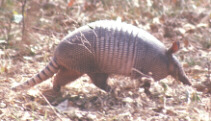Dasypus novemcinctus
Description
 The Nine-banded Armadillo is a cat-sized, armored, insect-eating mammal. Similar in form to an anteater, the bony, scaled shell of the armadillo protects
it from attacks by predators. Unfortunately, armadillos often fall victim to automobiles and are frequently found dead on roadsides.
The Nine-banded Armadillo is a cat-sized, armored, insect-eating mammal. Similar in form to an anteater, the bony, scaled shell of the armadillo protects
it from attacks by predators. Unfortunately, armadillos often fall victim to automobiles and are frequently found dead on roadsides.
A prolific digger, armadillos dig many burrows, as well as dig for food. Distribution is often determined by soil conditions, since the animal will not survive
in areas where the soil is too hard to dig. Many other wildlife species use and benefit from these abandoned burrows.
Although occasionally considered a nuisance by home owners, the armadillo's habit of digging up lawns is driven by its appetite for grubs, which can also harm
lawns.
Life History
Eats insects and other invertebrates. Skilled at digging for grubs. Occasionally eats berries and bird eggs.
Although breeding occurs in July, the embryo remains in a dormant state until November. Four young are born in a burrow in March. All four young, always of the
same sex, are identical quadruplets and developed from the same egg. They even share a single placenta while in the womb. Armadillos are the only mammals in which multiple young form from a single egg with any regularity.
Habitat and Distribution
The armadillo is the state mammal of Texas. Originally native to South America, the armadillo now ranges as far north as Texas, Oklahoma, Kansas and Louisiana.
Found in all but the western Trans-Pecos portion of Texas in a variety of habitats; brush, woods, scrub and grasslands.
All types of armadillos are in the endangered list. The Asian wild armadillo is found in Southwestern and central Asia.
James Rockaway, member
IndianwildlifeCub.com has these additional comments to offer.
Check out this armadillo.
Now, this rather dismal looking creature is called a nine banded armadillo and there are many in my area, as kids we used to catch them ,and play with them,
but always we let them go, because they eat insects, but unfortunately they also like to dig holes in the ground and even your garden and yard and you must be careful as not to step in their holes and break your ankle. When it is hot, the armadillos sleep,
but at dusk and night they crawl around like small army tanks. Their sight is not so good, so they are very easy to approach. To catch one all you do is grab his tail and hold on, but you must be careful because they have sharp digging claws, and will scratch
you if you handle them wrong, but once you rub an armadillos neck, he will just lay there docile and content. I like them even though they are not the most charming mammals:)